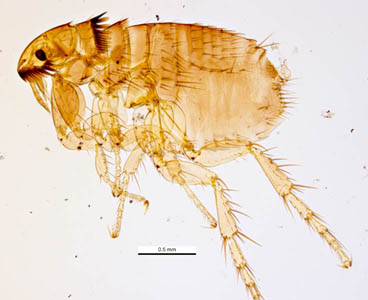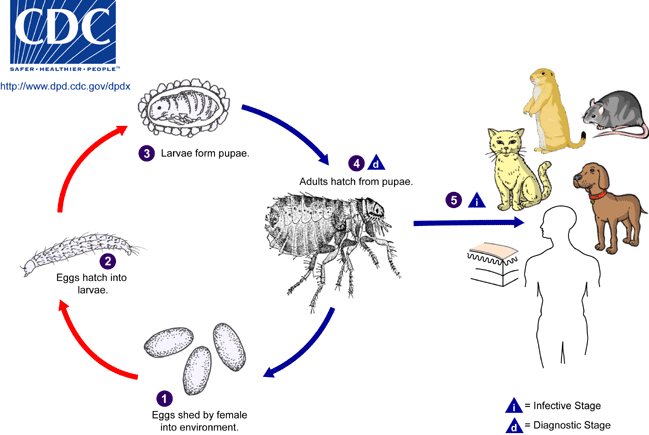Fleas do not have diseases on their own, just like humans they can get infected also. When fleas feed on disease stricken animals, they are infected but they become vectors instead transmitting those diseases when they feed on hosts.
So in a way yes, they can transmit diseases such as Bartonellosis (cat scratch fever) Plague and Marine Typhus. These arthropods are commonly found on dogs and cats. Some of these animals are allergic to flea saliva which leads to an allergic reaction called Flea Allergy Dermatitis (FAD). According to veterinary reports, half of the dermatological cases results from FAD.
Fleas are ectoparasites; which means they live and feed on their hosts throughout their lives. Another insect similar in feeding habit to fleas are Ticks. Ticks are ectoparasites that act as a vector for Lyme disease, the same way mosquitoes transmits malaria. In order to eradicate the threat of Lyme disease and other toxic effects of Ticks, it is important to take preventive measures against them.
What are Vector Transmitted Diseases?
Vector diseases are carried by organisms or people but they are not affected by it and in the same way, fleas and ticks are important vectors of various diseases which are not harmful to them in any way. Rather, they transmit these ailments to susceptible humans especially in North America where they are most common.
There are organizations created to take care parasitic attacks on animals, you can consult these group of professionals on the suitable methods to apply on your cats or dogs.
CAPC- Companion Animal Parasite Council
This organization is made up of veterinarians and other health professionals working independently to map out guidelines for the maximum control of external and internal parasites that pose a threat to humans and animals. It combines the expertise in internal medicine, public health, parasitology, veterinary law, association leadership, human health care to bring out the best results.
Annual Prevention
In your fight against external and internal parasites, it is important to be in close contact with your veterinarian. He/she will recommend the suitable products you can use to prevent the infestation or control it. Parasites don’t have a particular time of the year to feast on their hosts, they are annoyingly resilient even in extreme weather conditions. So, yearly application of preventive measure should never be swept aside even when it seems your environment is free from parasites.
FAQ’s about Ticks and fleas – Can an infested pet pose a threat to my family?
That’s a resounding YES. One infected flea is enough to wreak havoc in your family. One flea can transmit diseases to just about everyone in the family if left uncontrolled. Now, fleas reproduce at a fast rate, so that definitely multiplies the problem. Remember the Plague?
What are the diseases caused by Ticks?
There are many diseases transmitted by Ticks in North Africa alone, some of such diseases include Rocky Mountain fever, Ehrlichiosis, Lyme disease, Tick Paralysis and Tularemia. Your family and pet will suffer from these diseases if you don’t keep Tick and Flea infestation under control.
What if my Cat does not play Outdoors?
If your pet does not wander outside, they probably stand a lesser risk of being infested. However, rodents can carry parasites into your home and suddenly your ‘petless’ house is overrun by tiny little beasts feeding away.
Consequently, every unhygienic home with or without pets can be infested.
How to Protect your Home from Parasites
- Watch your toddlers closely, inspect everything they try to put in their mouth, it could turn out to be dirt even worse, flea dirt.
- Keep your home sandboxes covered, this should prevent it from getting contaminated with fecal matter.
- Pick up after your pet if they defecate, do not leave it lying around in the yard where your kids play, probably.
- If you come in contact with an animal, ensure that you wash your hands properly.
- Be sure to test your pet at least once a month in order to nip an infestation in the bud. Preventatives are effective at keeping ectoparasites away from your pets, administer them as advised by your veterinarian monthly.


